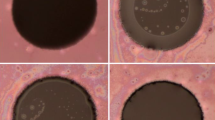Abstract
We propose a new method to fabricate micro-apertures for on-chip electrophysiological measurements of living cells. Thermal reflow of phosphosilicate glass (PSG) is applied to funnel- or nozzle-type microstructures to generate very smooth surfaces on the finalized chip. Such 3-dimensional microstructures show close similarities to fire-polished glass pipette tips. Immobilized cells fit perfectly to these structures offering a large contact area for sealing between the cell membrane and the oxide surface. A tight cell/chip-aperture seal is an important requirement for the present application. We demonstrate the formation of stable gigaseals with Chinese hamster ovary (CHO) cells for both types of microstructures without the need of any post-fabrication surface treatment. By adjusting the PSG reflow parameters, the shape of the apertures can be modified and diameters down to the sub-micrometer range may be achieved. The application of PSG reflow to MEMS fabrication is an interesting new option to create unconventional microstructures.







Similar content being viewed by others
References
Adams AC, Capio CD (1981) Planarization of phosphorus-doped silicon dioxide. J Electrochem Soc 128:423–429
Ashcroft FM (2000) Ion chanels and disease: channelopathies. Academic, San Diego
Asmild M et al (2003) Upscaling and automation of electrophysiology: toward high throughput screening in ion channel drug discovery. Receptors Channels 9:49–58
Bennett PB, Guthrie HRE (2003) Trends in ion channel drug discovery: advances in screening technologies. Trends Biotechnol 21:563–569
Bruggemann A et al (2003) High quality ion channel analysis on a chip with the NPC (c) technology. Assay Drug Dev Technol 1:665–673
Comley J (2003) Patchers versus screeners—divergent opinion on high throughput electro-physiology. Drug Discovery World: (Fall) 47–57
Hamill OP et al (1981) Improved patch-clamp techniques for high-resolution current recording from cells and cell-free membrane patches. Pflugers Archiv 391:85–100
Hara T, Suzuki H, Furukawa M (1984) Reflow of PSG layers by halogen lamp short duration heating technique. Jpn J Appl Phys Part 2 Lett 23:L452–L454
Ionescu-Zanetti C et al (2005) Mammalian electrophysiology on a microfluidic platform. Proc Natl Acad Sci USA 102:9112–9117
Jansen H et al (1995) The black silicon method—a universal method for determining the parameter setting of a fluorine-based reactive ion etcher in deep silicon trench etching with profile control. J Micromech Microeng 5:115–120
Klemic KG et al (2002) Micromolded PDMS planar electrode allows patch clamp electrical recordings from cells. Biosens Bioelectron 17:597–604
Klemic KG, Klemic JF, Sigworth FJ (2005) An air-molding technique for fabricating PDMS planar patch-clamp electrodes. Pflugers Archiv 449:564–572
Lehnert T, Gijs M (2004) Patch-clamp microsystems. In: Andersson H, van de Berg A (eds) Lab on chips for cellomics. Kluwer, Dordrecht
Lehnert T et al (2002) Realization of hollow SiO2 micronozzles for electrical measurements on living cells. Appl Phys Lett 81:5063–5065
Lehnert T, Laine A, Gijs M (2003) Surface modification of SiO2 micro-nozzles for patch-clamp measurements on-chip. In: Proceedings of 7th international conference on micro total analysis systems, Squaw Valley, California, USA, Transducers Research Foundation
Luginbuhl P et al (2000) Femtoliter injector for DNA mass spectrometry. Sens Actuators B Chem 63:167–177
Netzer R et al (2001) Screening lead compounds for QT interval prolongation. Drug Discov Today 6:78–84
Pantoja R et al (2004) Silicon chip-based patch-clamp electrodes integrated with PDMS microfluidics. Biosens Bioelectron 20:509–517
Sakmann B, Neher E (1995) Single-channel recording. Plenum Press, New York
Schroeder K et al (2003) IonWorks (TM) HT: a new high-throughput electrophysiology measurement platform. J Biomol Screen 8:50–64
Sigworth FJ, Klemic KG (2005) Microchip technology in ion-channel research. IEEE Trans Nanobioscience 4:121–127
van Stiphout P et al (2005) 3D microfluidic chip for automated patch-clamping VDE Verband der Elektrotechnik Elektronik Informationstechnik e.V., Berlin
Vassiliev VY et al (2000) Properties and gap-fill capability of HPD-CVD phosphosilicate glass films for subquarter-micrometer ULSI device technology. Electrochem Solid State Lett 3:80–83
Wang XB, Li M (2003) Automated electrophysiology: high throughput of art. Assay Drug Dev Technol 1:695–708
Willumsen NJ et al (2003) High throughput electrophysiology: new perspectives for ion channel drug discovery. Receptors Channels 9:3–12
Wood C, Williams C, Waldron GJ (2004) Patch clamping by numbers. Drug Discov Today 9:434–441
Worley JF, Main MJ (2002) An industrial perspective on utilizing functional ion channel assays for high throughput screening. Receptors Channels 8:269–282
Xu J et al (2001) Ion-channel assay technologies: quo vadis? Drug Discov Today 6:1278–1287
Xu J et al (2003) A benchmark study with SealChip (TM) planar patch-clamp technology. Assay Drug Dev Technol 1:675–684
Acknowledgments
The authors would like to thank Prof. J.-D. Horisberger (Department of Pharmacology and Toxicology, UNIL, CH-Lausanne) for stimulating discussions on issues related to the patch-clamp technique. The authors also thank the EPFL Center of MicroNano Technology (EPFL-CMI), in particular Dr. C. Hibert (dry etching) and Dr. Ph. Langlet (PSG deposition) for help in the process development, as well as Dr. D. Bouvet (EPFL-LEG1, chemical–mechanical polishing) and J. Steen (EPFL-LMIS1, AFM measurements).
Author information
Authors and Affiliations
Corresponding author
Rights and permissions
About this article
Cite this article
Lehnert, T., Nguyen, D.M.T., Baldi, L. et al. Glass reflow on 3-dimensional micro-apertures for electrophysiological measurements on-chip. Microfluid Nanofluid 3, 109–117 (2007). https://doi.org/10.1007/s10404-006-0111-x
Received:
Accepted:
Published:
Issue Date:
DOI: https://doi.org/10.1007/s10404-006-0111-x




